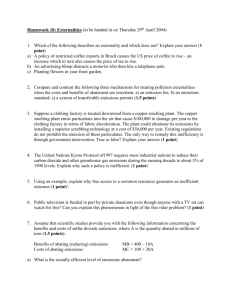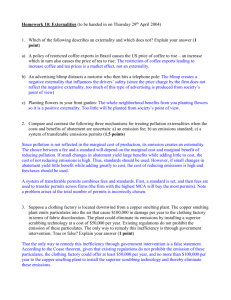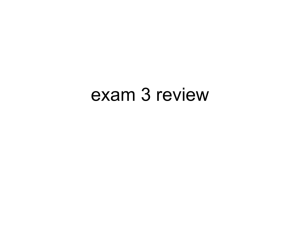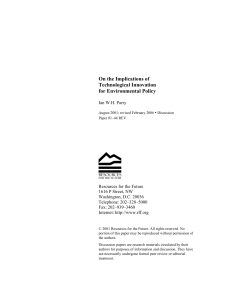Study Guide for Exam 2
advertisement
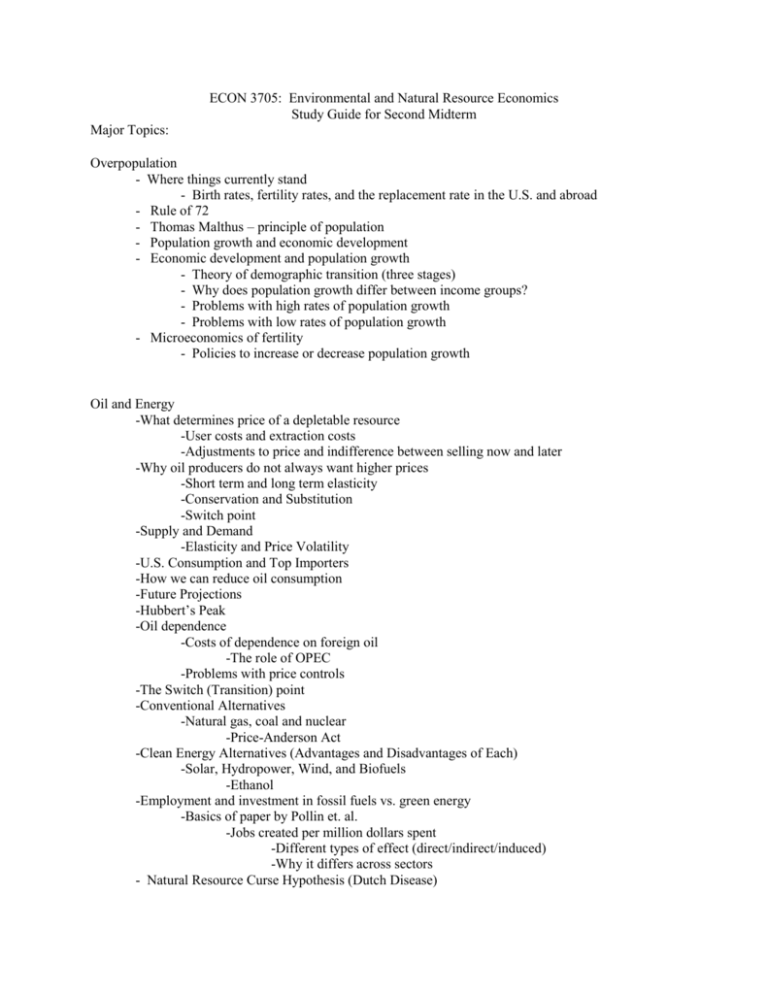
ECON 3705: Environmental and Natural Resource Economics Study Guide for Second Midterm Major Topics: Overpopulation - Where things currently stand - Birth rates, fertility rates, and the replacement rate in the U.S. and abroad - Rule of 72 - Thomas Malthus – principle of population - Population growth and economic development - Economic development and population growth - Theory of demographic transition (three stages) - Why does population growth differ between income groups? - Problems with high rates of population growth - Problems with low rates of population growth - Microeconomics of fertility - Policies to increase or decrease population growth Oil and Energy -What determines price of a depletable resource -User costs and extraction costs -Adjustments to price and indifference between selling now and later -Why oil producers do not always want higher prices -Short term and long term elasticity -Conservation and Substitution -Switch point -Supply and Demand -Elasticity and Price Volatility -U.S. Consumption and Top Importers -How we can reduce oil consumption -Future Projections -Hubbert’s Peak -Oil dependence -Costs of dependence on foreign oil -The role of OPEC -Problems with price controls -The Switch (Transition) point -Conventional Alternatives -Natural gas, coal and nuclear -Price-Anderson Act -Clean Energy Alternatives (Advantages and Disadvantages of Each) -Solar, Hydropower, Wind, and Biofuels -Ethanol -Employment and investment in fossil fuels vs. green energy -Basics of paper by Pollin et. al. -Jobs created per million dollars spent -Different types of effect (direct/indirect/induced) -Why it differs across sectors - Natural Resource Curse Hypothesis (Dutch Disease) Overview of Utica Shale Exploration in Ohio (Jeffrey Dick Presentation) -Basics of: -The history -Distinction between Marcellus and Utica Shale -Geographical distinction between oil, wet gas, and dry gas -Why natural gas prices are so low -Current Utica activity -Environmental Concerns Pollution Control - How to determine efficient level of pollution - How marginal damages/marginal costs influence efficient level - Net benefit/inefficiency areas on MB/MC graphs - Ambient Standards (Command and Control) i. Why it’s cost ineffective ii. Equimarginal principle - Command and Control, Emission Taxes, Marketable Pollution Permits - How they function - What determines cost effectiveness - Costs to firms - Advantages/Disadvantages Practice Problems Note: The test will consist of approximately 20 multiple choice and 7 short answer questions. The practice problems are intended just to get you thinking about some of the topics you’ll be asked about on the exam. 1. Suppose world population grows at a rate of 2% year. If the current world population is 7 billion, in how many years will the world population equal 14 billion? 2. Why did Thomas Malthus predict overpopulation would result in mass starvation and misery? What was the major flaw in his theory? 3. On a clearly labeled set of axes, graph the birth rate and death curves associated with the Theory of Demographic Transition. Also point out where the approximate cutoff points are for the three stages directly on your graph. 4. Suppose a country has an average labor productivity equal to $50,000 and the share of the population employed equals 40%. What is the per capita income in this country? 5. What indirect methods can policymakers employ to reduce population growth? 6. What is marginal user cost and what determines whether and how it changes? 7. Why don’t all oil producing entities always want higher current prices for oil? 8. Is the price elasticity of demand and supply of oil inelastic or elastic in the short run? Does the elasticity of demand become more elastic or inelastic over time? Explain. 9. Explain why the price of oil has historically been highly volatile. 10. Explain why the world won’t run out of oil anytime soon. 11. At current rates of usage and known reserves, approximately when would the world run out of oil? 12. Draw the graph of a monopoly. If this represents OPEC cartel, indicate the areas of loss to society (deadweight loss) and the area of loss to U.S. consumers. 13. What can the government do to help facilitate a reduced dependence on oil? What can they do to reduce dependence on foreign oil? What can they do to reduce the price of gasoline? 14. What are the top 5 energy sources in the U.S.? How have these been changing over time? 15. List the major advantages and disadvantages associated with natural gas, coal, nuclear energy, wind, and solar energy. 16. Explain the Price-Anderson Act and what its likely impact to energy companies that use nuclear energy? 17. Explain the basis of the “Natural Resource Curse” and why it is sometimes referred to as “Dutch Disease.” 18. Suppose a windmill costs $80,000 to build, will last for 30 years, and will reduce electric costs by 30%. What must the minimum annual electric costs equal for this to be a worthwhile investment? 19. Explain why most economists and energy experts believe that mandating the usage corn ethanol is not good policy. 20. According to the paper “Green Recovery” by Pallin et. al., what would be the net effect in terms of jobs created or lost of investing $5 million less in fossil fuels and $5 million more in alternative energy? 21. What are the two major reasons that Pallin et. al. find that more jobs are created per dollar spent on alternative energies compared to fossil fuels. 22. What must be true for society to be better off from a reduction in pollution emissions? What must be true for society to be worse off from a reduction in pollution emissions? 23. Firms emit two pollutants, stoo and goo. The marginal damages associated with each pollutant are equal for all quantities; however, it always costs firms less to reduce their stoo emissions compared to their goo emissions. What is true as far as the efficient level of stoo and goo emissions? 24. Firms emit two pollutants, stoo and goo. The marginal abatement costs associated with each pollutant are equal for all quantities; however, the marginal damages associated goo emissions are greater than the marginal damages associated with stoo emissions. What is true as far as the efficient level of stoo and goo emissions? 25. Use the following table on firms’ pollution emissions to answer the following questions. Quantity of pollution abatement 1 2 3 4 5 Firm A’s MC of abatement $20 $40 $60 $80 $100 Firm B’s MC of abatement $5 $8 $20 $30 $40 Suppose the efficient level of abatement is 4 tons. How much should firm A and firm B reduce their emissions in order to achieve this reduction at least cost? What pollution tax level would result in this outcome? Suppose the efficient level of abatement is 4 tons. How much should firm A and firm B reduce their emissions in order to achieve this reduction at least cost? What pollution tax level would result in this outcome? 26. The graph below shows the marginal cost of controlling pollution (abatement costs) for a firm. $ MC 40 30 20 10 20 40 60 80 100 Tons of Emissions a) If the government instituted a per-unit emissions tax of $20/ton, what are the total costs to the firm above would equal? b) What are the total costs to society? c) If the tax increased to $30, what is the new emissions level for this firm and what is their new total costs? 27. There are 4 firms emitting different levels of SO2 that have different control costs. Firm A currently emits 100 tons and has a MC of $200/ton. Firm B currently emits 50 tons and has a MC of $100/ton. Firm C currently emits 200 tons and has a MC of $300/ton. Firm D currently emits 50 tons and has a MC of $50/ton. a) If the government makes each firm cut there emissions in half, what would the total cost to firms equal? b) What would an emissions tax need to equal in order to achieve the same reduction in emissions? c) How much would all firms pay as a result of this tax? d) What are the gains to society of using a tax over command and control? e) If the government uses marketable pollution permits, how many would they need to distribute in total? How would they have to be distributed? 28. Explain why an emissions charge program (tax) and a marketable pollution permit system lead to identical marginal costs of pollution abatement across firms. 29. On a clearly labeled set of axes, draw a MB/MC graph which illustrates a situation in which you would recommend to policy makers that there be no policies implemented to reduce pollution. 30. On a clearly labeled set of axes, draw a MB/MC graph which illustrates a situation in which zero is the efficient level of pollution.

